About two years have now passed since the Low-Dose Radiation Research Center was first established in October 2000.
We feel that this then would be a suitable time for us to provide this report, The promotion of comprehensive research into the effects of low dose radiation and the release of information, outlining the course of the establishment of the center and the current state of our activities.
|
|
|
 |
< March 1998 survey >
Do you think that nuclear power generation should be actively promoted?
1. It should be promoted actively.
2. It should be promoted cautiously.
3. It should not be promoted more than at present.
4. Nuclear power generation should be terminated.
5. Don't know, no response
Source: NHK public opinion survey
|
The graph given here represents a summary of the outcome of the public opinion survey regarding the future of nuclear power generation conducted by the Japan Broadcasting Corporation (NHK) in March 1998 as well as changes up to the present. This indicates that, as of March 1998, about 63% of those questioned responded that nuclear power generation should be promoted actively (7.8%) or should be promoted cautiously (55.2%), indicating that there are more people who support nuclear power generation than those who are opposed to it.
However, at around the time of the Chernobyl accident in April 1986, there was a rapid increase in the proportion of those who responded that nuclear power generation should not be promoted beyond the present level. Given this response, it would not be possible to ignore the negative effects of the JCO accident, which occurred after the above survey was conducted, on people who supported nuclear power generation and it cannot be denied that it has aroused feelings of uneasiness about radiation.
Taking this into account, we feel that:
- The time has come when it is necessary for an organization trusted as a group of professionals to conduct research on the effects of low dose radiation,
- Serve as the nucleus in the formation of a national network
- Promote joint research
- And properly comprehend the effects of low dose radiation on living organisms and make that information widely available.
|
We are promoting cooperation with outside research institutions, undertaking research projects to comprehensively elucidate the effects of radiation at the molecular, cellular and whole body level from a diversity of perspectives and are moving ahead with research with goals based on the following three cornerstones:
1. Proper understanding of the effects of low dose radiation on living organisms,
2. Review of radiation protection standards and
3. Pursuit of applicability to medical treatment
|
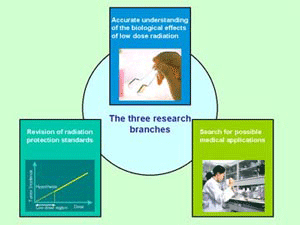
|
The level of the effects of radiation on living organisms differs greatly depending on the length of time, whether a short period or continuously over a long period, of exposure to the same degree of radiation. For example, the minimum level of radiation reported thus far in the research literature that is recognized to be the cause of cancer is 100mSv under the single exposure conditions of Hiroshima or Nagasaki, while, in the case of long-term exposure, the occurrence of cancer is not recognized until the level reaches almost 500mSv.
The results of long-term irradiation indicated in the literature was obtained from experimental data using laboratory animals and, when the level of exposure is decreased further to that of natural background radiation, the effects of radiation are not longer recognizable. Incidentally, the level of natural background radiation also differs greatly depending on the location. The degree of natural background radiation to which people are exposed during the period of a year in Japan is in the range of about 1mSv on average (excluding the effects of radon), while it is about ten times that in Brazil and about 20 times in Iran.
|

|
Some parts of the Ramsar region of Iran, in particular, reach a level of nearly 130 times. Even so, people carry on with their lives as usual in those areas. If we consider the human lifespan to be about 70 years, the total exposure to radiation throughout our lives would be about 80mSv in Japan and from 1,000mSv to almost 10,000mSv in Iran. It would not be unusual to find differences in the cancer occurrence rate and there is quite a large number of people in Iran who contract cancer. There are no reports, however, that indicate a greater increase in the cancer rate in Iran or Brazil than in Japan or that they have a shorter lifespan.
Thus, the effects of radiation are complex and the effects of low dose radiation and the low dose-rate irradiation on living organisms has still not been adequately elucidated.
Even so, there are many people who think that radiation is simply harmful and nothing else.
|
What is the origin of this way of thinking? We think that one major cause can be found in the authoritative International Commission on Radiological Protection (ICRP). This organization has hypothesized that there is non threshold value for cancer risk and that the cancer rate increases in proportion to the amount of exposure to radiation without even venturing very deeply into the effects of still-unknown low dose and low dose-rate radiation from the perspective of radiological protection. Without even realizing it, this has come to be accepted as an index for the effects of radiation on living organisms.
|
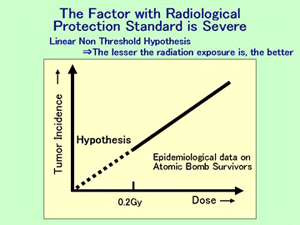 |
Judging from data from Hiroshima and Nagasaki, it is undeniably true that the cancer rate increases in proportion to the amount of exposure to radiation in the case of people who have been exposed to a high level of radiation. There is no data whatsoever, however, that shows that the cancer rate increases with a low level of exposure. On the contrary, there are even reports indicating that the cancer rate actually declines in a certain region of radiation. Furthermore, virtually no experiments had been conducted that examine the effects on living organisms of long-term exposure to low dose-rate radiation.
|
LDRC thus established Long-term low dose rate irradiation facilities using Cs-137 (Cesium 137) as a gamma-ray source capable of constant irradiation of mice and other laboratory animals under long-term conditions. Our intention was to study experimentally whether or not the cancer rate of the laboratory animals changed with constant long-term irradiation, fluctuating radiation dose-rate by changing the distance from the radiation source.
|

|
The radiation dose-rate in our Long-term low dose rate irradiation facilities can currently be adjusted within the range of 100-1,000 times the level of natural background radiation. We had previously used x-ray equipment and were not able to create an environment for irradiation with low dose radiation.
|
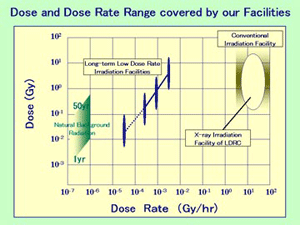
|
In the experiments, we used laboratory mice available on the market (ICR mice) that are used in large quantities in research in radiation effects. We decided to observe the course of events to see if a difference occurs in the cancer rate when we injected the carcinogen methylcholanthrene into the groin of the mice and exposed them to constant irradiation for a comparison to mice that were not irradiated.
|

|
The mice were positioned at distances of 3m, 5m and 10m from the radiation source and behind a concrete wall (for the sake of comparison, we also used non-irradiated mice). The radiation dose-rates at distances of 3m, 5m and 10m were 2.6Gy/hr, 0.95Gy/hr and 0.3Gy/hr.
|

|
In the experiments, 35 6-week old ICR mice each were placed in the prescribed locations in the laboratory and, in order to familiarize them with the environment, we at first used only radiation for a period of 35 days. Following that, we injected doses of the carcinogen and observed the course of events for a period of about 200 days while applying radiation.
|
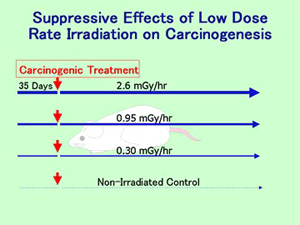
|
Here is an example of the experimental results. The horizontal axis indicates the days after carcinogen injection and the vertical axis represents the tumor rate. The following is evident based on the results.
- No difference in cancer rate was observed between irradiated and non-irradiated mice at a distance of 10m from the radiation source.
- A statistically significant decline in the tumor rate was observed in mice positioned at a distance of 5m.
|
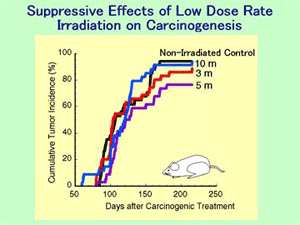
|
- Though there was no statistically significant difference in mice placed at a distance of 3m, a tendency toward a decline in the tumor rate was observed.
In other words, this can be summarized as follows:
- Conditions of low dose-rate irradiation give rise to a cancer suppression effect and that effect appears to have an optimal dose-rate.
- The emergence of this cancer suppression effect cannot be explained by the approach of the ICRP, which holds that the cancer rate increases in proportion to the amount of radiation exposure, and suggests the need to review the so-called Linear Non Threshold (LNT) hypothesis proposed heretofore by the ICRP as well as a new method for evaluating effects as an alternative to this.
|
The indication of a cancer suppression effect in humans due to low dose radiation has also been experienced at medical treatment sites.
How does this cancer suppression effect come into play? First of all, there is the carcinogenic mechanism, which is generally thought to function as indicated below.
- There are various causes of cancer in the environment in which people live. They cause damage directly to the DNA or produce a reactive substance in the body known as reactive oxygen species that causes damage to the DNA.
|
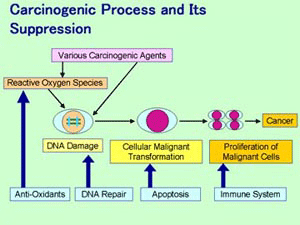
|
- Cells with damaged DNA have a certain probability to develop into cancer cells.
- When cancer cells deviate from normal multiplication and rampant cell multiplication takes place, the condition transforms into cancer as a disease.
Low dose radiation has the function of a trigger that prevents the advance of the process that culminates in the occurrence of cancer. In other words, we hypothesize that mechanisms for the protection of the organism such as those described below work effectively through low dose radiation and prevent the occurrence of the adverse effects of radiation that result in cancer and are currently concentrating our efforts on verifying this through animal experiments:
1. The production of reactive oxygen species is sensed and the function of producing antioxidants for its removal is strengthened.
2. The function of repairing damaged DNA is strengthened.
3. The function of activation of the mechanism of apoptosis, which causes the self-destruction of cancerous cells, is strengthened.
4. The function of immunity that annihilates cancer cells is strengthened.
|
As an interesting example of the response of living organisms, let us introduce the case of the suppression of diabetes through low dose radiation.
There are two types of diabetes, type I which is dependent on insulin and is common among young people, and type II, which is seen more commonly among adults. Type II is the type that is said to be common among Japanese people.
|
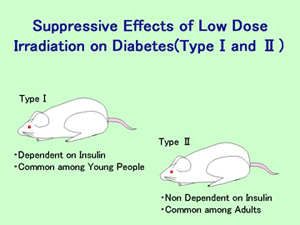
|
First of all is an introduction to experiments conducted relating to type I diabetes. Special mice that naturally contract type I diabetes at the age of about 15 weeks were used in the experiments. The mice were irradiated with low dose radiation once each after the 12th, 13th and 14th weeks. We found that the occurrence of diabetes was significantly suppressed in mice irradiated after the elapse of 12 weeks.
|

|
Meanwhile, in the case of type II diabetes, we undertook experiments using type II diabetes model mice that contract diabetes at a young age. We irradiated them continuously with low dose radiation for a period of about 80 weeks and then examined whether or not there was any indication of improvement in the symptoms of type II diabetes, which they had already contracted by the time irradiation started. Surprisingly, after about 20 weeks of irradiation, notable improvement was evident in three of twelve specimens and we are confirming whether or not these conditions will continue for a sustained period of time.
|
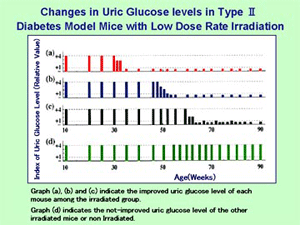
|
In addition, when we observed the sheen of the fur and skin condition of the irradiated and non-irradiated mice, the irradiated mouse population maintained a youthful condition while, in contrast, conditions of partial fur loss and hardening of the skin were observed in the non-irradiated mouse population, suggesting that exposure to low-dose radiation perhaps slowed the aging process in the mice.
|
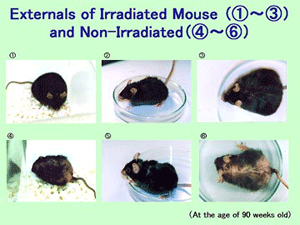
|
The effects in suppressing cancer and diabetes, and improvements in symptoms due to exposure to low dose radiation introduced above are phenomena that cannot be explained by the Linear Non Threshold (LNT) hypothesis adopted by the International Commission on Radiological Protection (ICRP) and contradicts the established radiation paradigm that even the most trivial radiation has a damaging effect on the body.
We hypothesize that the effects on the body of low dose radiation and high dose radiation are completely different and intend to verify this within the next two or three years.
Unlike the conventional approach to the effects of radiation, which focuses only on those cells that have been subjected to irradiation, the primary characteristic of this model is that individual cells form a community to prevent the occurrence of the adverse effects of radiation and, while exchanging information with neighboring cells, cooperate closely together to repair genetic damage or eliminate cells that have been impacted.
|
|
|
Given the course of the evolution of life on Earth, our approach can probably been seen as an extremely natural one. That is, ever since the Earth first came into existence about 4.5 billion years ago, the natural environment has been exposed to radiation from space and from the land and living organisms have continued to be born, evolve and live in close contact with radiation over the millennia.
Considering that evolution, it seems entirely natural to us that life on Earth accepts low dose radiation as a stimulus and has been endowed with biophylactic functions for this, and that low dose radiation may also produce positive effects such as suppressing cancer.
|
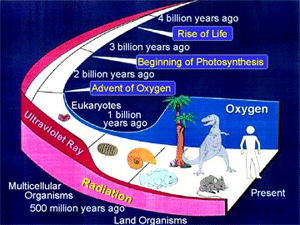
|
The Low Dose Radiation Research Center is further strengthening collaboration with outside research institutes, is committed to gaining a proper understanding of the effects of low dose radiation as a center of a research network and we hope to be able to contribute to alleviating the feelings of insecurity that many people have regarding radiation.
|
